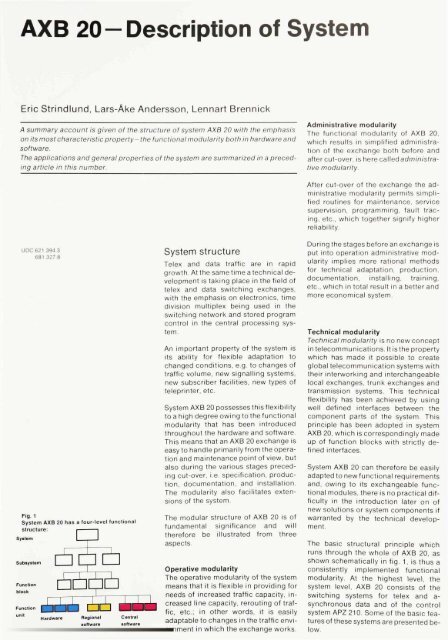Yngve Rapp - The history of Ericsson
Yngve Rapp - The history of Ericsson
Yngve Rapp - The history of Ericsson
You also want an ePaper? Increase the reach of your titles
YUMPU automatically turns print PDFs into web optimized ePapers that Google loves.
AXB 20—Description <strong>of</strong> System<br />
Eric Strindlund, Lars-Åke Andersson, Lennart Brennick<br />
A summary account is given <strong>of</strong> the structure <strong>of</strong> system AXB 20 with the emphasis<br />
on its most characteristic property- the functional modularity both in hardware and<br />
s<strong>of</strong>tware.<br />
<strong>The</strong> applications and general properties <strong>of</strong> the system are summarized in a preceding<br />
article in this number.<br />
UDC 621 394 3<br />
681 327 8<br />
Fig. 1<br />
System AXB 20 has a four-level functional<br />
structure:<br />
System structure<br />
Telex and data traffic are in rapid<br />
growth. At the same time a technical development<br />
is taking place in the field <strong>of</strong><br />
telex and data switching exchanges,<br />
with the emphasis on electronics, time<br />
division multiplex being used in the<br />
switching network and stored program<br />
control in the central processing system.<br />
An important property <strong>of</strong> the system is<br />
its ability for flexible adaptation to<br />
changed conditions, e.g. to changes <strong>of</strong><br />
traffic volume, new signalling systems,<br />
new subscriber facilities, new types <strong>of</strong><br />
teleprinter, etc.<br />
System AXB 20 possesses this flexibility<br />
to a high degree owing to the functional<br />
modularity that has been introduced<br />
throughout the hardware and s<strong>of</strong>tware.<br />
This means that an AXB 20 exchange is<br />
easy to handle primarily from the operation<br />
and maintenance point <strong>of</strong> view, but<br />
also during the various stages preceding<br />
cut-over, i.e. specification, production,<br />
documentation, and installation.<br />
<strong>The</strong> modularity also facilitates extensions<br />
<strong>of</strong> the system.<br />
<strong>The</strong> modular structure <strong>of</strong> AXB 20 is <strong>of</strong><br />
fundamental significance and will<br />
therefore be illustrated from three<br />
aspects.<br />
Operative modularity<br />
<strong>The</strong> operative modularity <strong>of</strong> the system<br />
means that it is flexible in providing for<br />
needs <strong>of</strong> increased traffic capacity, increased<br />
line capacity, rerouting <strong>of</strong> traffic,<br />
etc.; in other words, it is easily<br />
adaptable to changes in the traffic envi-<br />
••rment in which the exchange works.<br />
Administrative modularity<br />
<strong>The</strong> functional modularity <strong>of</strong> AXB 20,<br />
which results in simplified administration<br />
<strong>of</strong> the exchange both before and<br />
after cut-over, is here called administrative<br />
modularity.<br />
After cut-over <strong>of</strong> the exchange the administrative<br />
modularity permits simplified<br />
routines for maintenance, service<br />
supervision, programming, fault tracing,<br />
etc., which together signify higher<br />
reliability.<br />
During the stages before an exchange is<br />
put into operation administrative modularity<br />
implies more rational methods<br />
for technical adaptation, production,<br />
documentation, installing, training,<br />
etc., which in total result in a better and<br />
more economical system.<br />
Technical modularity<br />
Technical modularity is no new concept<br />
in telecommunications. It isthe property<br />
which has made it possible to create<br />
global telecommunication systems with<br />
their interworking and interchangeable<br />
local exchanges, trunk exchanges and<br />
transmission systems. This technical<br />
flexibility has been achieved by using<br />
well defined interfaces between the<br />
component parts <strong>of</strong> the system. This<br />
principle has been adopted in system<br />
AXB 20, which is correspondingly made<br />
up <strong>of</strong> function blocks with strictly defined<br />
interfaces.<br />
System AXB 20 can therefore be easily<br />
adapted to new functional requirements<br />
and, owing to its exchangeable functional<br />
modules, there is no practical difficulty<br />
in the introduction later on <strong>of</strong><br />
new solutions or system components if<br />
warranted by the technical development.<br />
<strong>The</strong> basic structural principle which<br />
runs through the whole <strong>of</strong> AXB 20, as<br />
shown schematically in fig. 1, is thus a<br />
consistently implemented functional<br />
modularity. At the highest level, the<br />
system level, AXB 20 consists <strong>of</strong> the<br />
switching systems for telex and asynchronous<br />
data and <strong>of</strong> the control<br />
system APZ 210. Some <strong>of</strong> the basic features<br />
<strong>of</strong> these systems are presented below.
















